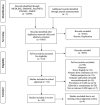Addressing Complementary and Alternative Medicine Use Among Individuals With Cancer: An Integrative Review and Clinical Practice Guideline
- PMID: 33769512
- PMCID: PMC8755493
- DOI: 10.1093/jnci/djab048
Addressing Complementary and Alternative Medicine Use Among Individuals With Cancer: An Integrative Review and Clinical Practice Guideline
Abstract
Complementary and alternative medicine (CAM) use is common among individuals with cancer, but many choose not to discuss CAM with health-care providers (HCPs). Moreover, there is variability in the provision of evidence-informed decision making about CAM use. A clinical practice guideline was developed to standardize how oncology HCPs address CAM use as well as to inform how individuals with cancer can be supported in making evidence-informed decisions about CAM. An integrative review of the literature, from inception to December 31, 2018, was conducted in MEDLINE, EMBASE, PsychINFO, CINAHL, and AMED databases. Eligible articles included oncology HCPs' practice related to discussing, assessing, documenting, providing decision support, or offering information about CAM. Two authors independently searched the literature, and selected articles were summarized. Recommendations for clinical practice were formulated from the appraised evidence and clinical experiences of the research team. An expert panel reviewed the guideline for usability and appropriateness and recommendations were finalized. The majority of the 30 studies eligible for inclusion were either observational or qualitative, with only 3 being reviews and 3 being experimental. From the literature, 7 practice recommendations were formulated for oncology HCPs regarding how to address CAM use by individuals with cancer, including communicating, assessing, educating, decision coaching, documenting, active monitoring, and adverse event reporting. It is imperative for safe and comprehensive care that oncology HCPs address CAM use as part of standard practice. This clinical practice guideline offers directions on how to support evidence-informed decision making about CAM among individuals with cancer.
© The Author(s) 2021. Published by Oxford University Press. All rights reserved. For permissions, please email: journals.permissions@oup.com.
Figures
References
-
- National Center for Complementary and Integrative Health. Complementary, alternative, or integrative health: What’s in a name? https://www.nccih.nih.gov/health/complementary-alternative-or-integrativ...15, 2021.
-
- Johnson SB, Park HS, Gross CP, Yu JB.. Use of alternative medicine for cancer and its impact on survival. J Natl Cancer Inst .2018;110(1):121–124. - PubMed
-
- Patterson RE, Neuhouser ML, Hedderson MM, et al.Types of alternative medicine used by patients with breast, colon, or prostate cancer: predictors, motives, and costs. J Altern Complement Med. 2002;8(4):477–485. - PubMed
Publication types
MeSH terms
LinkOut - more resources
Full Text Sources
Other Literature Sources
Medical


